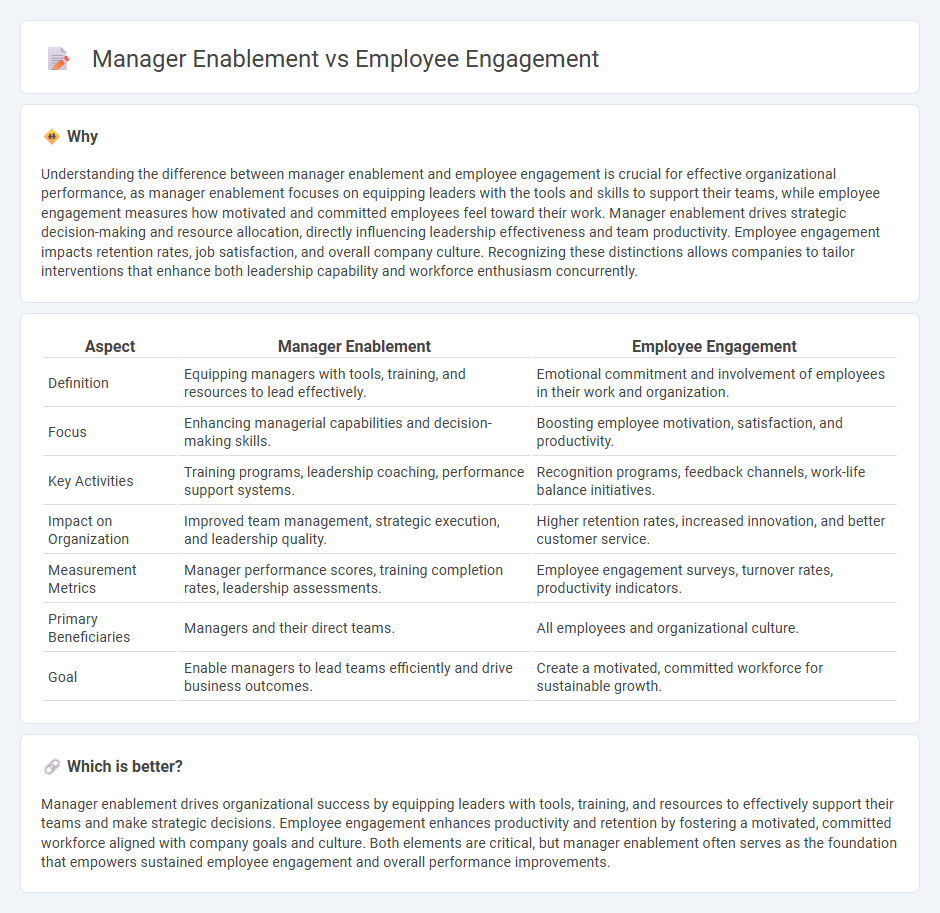
Manager enablement focuses on equipping managers with the tools, skills, and resources to lead effectively and drive team performance. Employee engagement centers on fostering a workplace environment where employees feel motivated, valued, and connected to their work and organization. Explore the dynamics between manager enablement and employee engagement to enhance organizational success.
Why it is important
Understanding the difference between manager enablement and employee engagement is crucial for effective organizational performance, as manager enablement focuses on equipping leaders with the tools and skills to support their teams, while employee engagement measures how motivated and committed employees feel toward their work. Manager enablement drives strategic decision-making and resource allocation, directly influencing leadership effectiveness and team productivity. Employee engagement impacts retention rates, job satisfaction, and overall company culture. Recognizing these distinctions allows companies to tailor interventions that enhance both leadership capability and workforce enthusiasm concurrently.
Comparison Table
| Aspect | Manager Enablement | Employee Engagement |
|---|---|---|
| Definition | Equipping managers with tools, training, and resources to lead effectively. | Emotional commitment and involvement of employees in their work and organization. |
| Focus | Enhancing managerial capabilities and decision-making skills. | Boosting employee motivation, satisfaction, and productivity. |
| Key Activities | Training programs, leadership coaching, performance support systems. | Recognition programs, feedback channels, work-life balance initiatives. |
| Impact on Organization | Improved team management, strategic execution, and leadership quality. | Higher retention rates, increased innovation, and better customer service. |
| Measurement Metrics | Manager performance scores, training completion rates, leadership assessments. | Employee engagement surveys, turnover rates, productivity indicators. |
| Primary Beneficiaries | Managers and their direct teams. | All employees and organizational culture. |
| Goal | Enable managers to lead teams efficiently and drive business outcomes. | Create a motivated, committed workforce for sustainable growth. |
Which is better?
Manager enablement drives organizational success by equipping leaders with tools, training, and resources to effectively support their teams and make strategic decisions. Employee engagement enhances productivity and retention by fostering a motivated, committed workforce aligned with company goals and culture. Both elements are critical, but manager enablement often serves as the foundation that empowers sustained employee engagement and overall performance improvements.
Connection
Manager enablement enhances leadership capabilities by providing tools, training, and resources that empower managers to support their teams effectively. This empowerment directly boosts employee engagement by fostering clear communication, recognition, and motivation within the workforce. High levels of manager enablement correlate with increased employee satisfaction, productivity, and retention rates across organizations.
Key Terms
Motivation
Employee engagement centers on fostering intrinsic motivation by aligning personal values and goals with organizational objectives, leading to higher productivity and job satisfaction. Manager enablement emphasizes equipping leaders with the tools, skills, and authority to inspire and motivate their teams effectively, directly impacting overall workforce morale and performance. Explore strategies to balance employee engagement and manager enablement for maximizing motivation in your organization.
Empowerment
Employee engagement centers on fostering motivation, satisfaction, and commitment within the workforce to enhance productivity and reduce turnover. Manager enablement emphasizes equipping leaders with the tools, skills, and authority necessary to support their teams effectively and drive organizational success. Explore how prioritizing empowerment in both areas leads to a cohesive and high-performing workplace culture.
Performance
Employee engagement drives individual motivation and commitment, directly impacting overall performance and productivity within organizations. Manager enablement equips leaders with tools, training, and resources necessary to guide teams effectively, fostering an environment where employee engagement can flourish. Discover how integrating both strategies can optimize performance outcomes in your business.
Source and External Links
Why Employee Engagement is Key to Company Success - This article highlights the importance of employee engagement in enhancing productivity, profitability, and overall organizational success by fostering a sense of belonging and personalized communication.
How to Improve Employee Engagement in the Workplace - Gallup discusses the benefits and strategies for improving employee engagement, including higher productivity, lower absenteeism, and better business outcomes.
What is Employee Engagement? (And How to Boost It) - This article defines employee engagement as a critical factor in workplace success, contributing to increased productivity, employee retention, and customer satisfaction.
 dowidth.com
dowidth.com